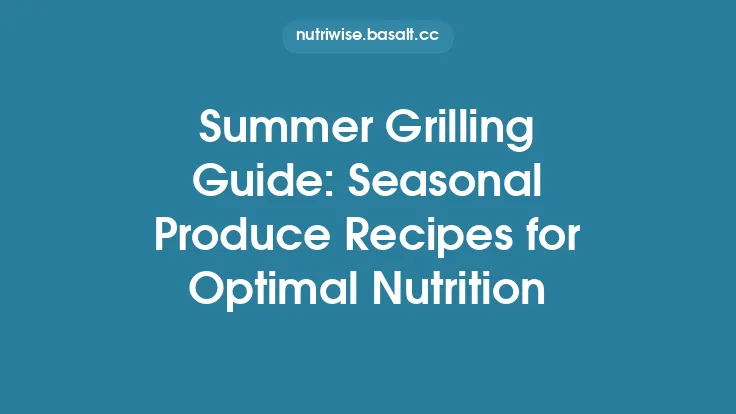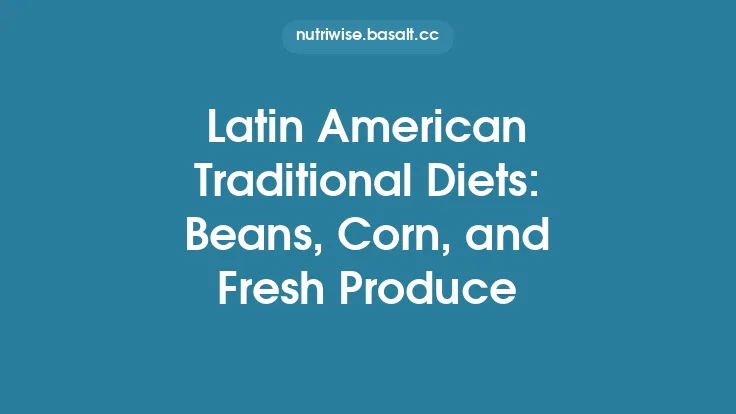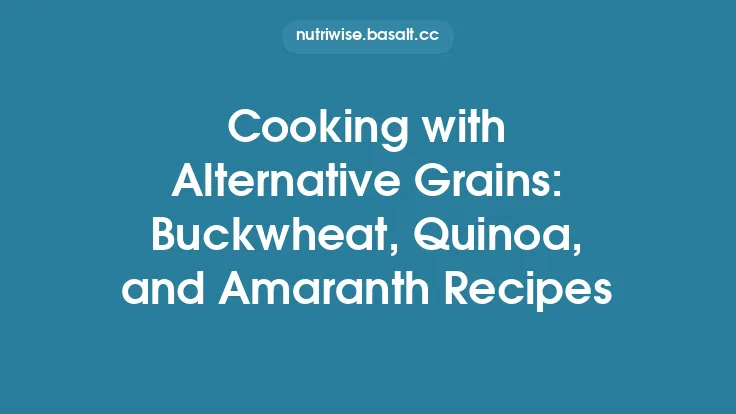Fresh, seasonal produce is the cornerstone of vibrant, nutritious meals, yet its true potential is only realized when it is stored and prepared correctly. The difference between a crisp, sweet carrot and a limp, flavor‑less one often lies not in the garden but in the minutes, hours, and days that follow harvest. This guide walks you through the science‑backed fundamentals of preserving the peak quality of fruits and vegetables from farm to table, giving you the confidence to keep your pantry stocked with the very best of each season.
Understanding Seasonal Produce
Why Seasonality Matters
- Nutrient density: Produce harvested at its natural peak contains higher concentrations of vitamins, minerals, antioxidants, and phytonutrients.
- Flavor profile: Natural sugars, acids, and aromatic compounds develop fully when plants complete their growth cycle without artificial ripening.
- Environmental impact: Local, in‑season foods travel shorter distances, reducing carbon footprints and supporting regional agriculture.
Typical Seasonal Windows (Northern Hemisphere)
| Season | Common Fruits | Common Vegetables |
|---|
| Spring | Strawberries, apricots, rhubarb | Asparagus, peas, radishes, early lettuce |
| Summer | Berries, peaches, cherries, melons | Tomatoes, zucchini, corn, bell peppers |
| Autumn | Apples, pears, grapes, pomegranates | Squash, carrots, Brussels sprouts, kale |
| Winter | Citrus, kiwis, persimmons | Root vegetables, cabbage, leeks, potatoes |
Understanding these windows helps you anticipate when to buy in bulk, when to prioritize fresh consumption, and when to shift toward preservation methods.
Principles of Proper Storage
The Four Pillars of Produce Longevity
- Temperature – Most vegetables thrive at 0–4 °C (32–39 °F); many fruits prefer slightly warmer conditions (4–10 °C).
- Humidity – High relative humidity (90–95 %) slows water loss in leafy greens, while low humidity (50–60 %) is better for mushrooms and onions.
- Ethylene Sensitivity – Some fruits (e.g., apples, bananas) emit ethylene gas, accelerating ripening in nearby ethylene‑sensitive produce (e.g., broccoli, lettuce).
- Physical Integrity – Bruising or cuts create entry points for microbes; handle gently and keep surfaces clean.
Sorting Before Storage
- Inspect each item for soft spots, mold, or insect damage.
- Separate ethylene producers from ethylene‑sensitive items to prevent premature ripening.
- Group by similar storage needs (e.g., keep high‑humidity greens together, store low‑humidity root crops separately).
Refrigeration Techniques
Crisper Drawer Optimization
- Adjustable humidity controls: Set the high‑humidity setting for leafy greens, herbs, and carrots; low‑humidity for fruits like apples and pears.
- Use perforated produce bags or reusable mesh bags to maintain airflow while retaining moisture.
Shelf‑Stable Refrigeration
- Egg‑carton style containers: Ideal for mushrooms, which prefer a dry, ventilated environment.
- Paper towels: Line containers for berries to absorb excess moisture, extending shelf life by up to 3 days.
Temperature Mapping
- Thermometer placement: Place a digital probe in the coldest part of the fridge (usually the back of the bottom shelf) and adjust the thermostat to maintain a steady 2 °C (35.6 °F) for most vegetables.
- Avoid door storage: The door experiences temperature fluctuations; reserve it for condiments and non‑perishable items.
Root Cellar & Cool Storage
Ideal Conditions
- Temperature: 0–4 °C (32–39 °F) for most root vegetables.
- Relative humidity: 85–95 % to prevent desiccation.
- Ventilation: Gentle airflow to avoid mold buildup.
Preparing Produce for Cellar Storage
- Cure: Allow potatoes, onions, and garlic to sit in a dark, well‑ventilated area for 1–2 weeks to toughen skins.
- Brush, don’t wash: Remove soil with a soft brush; excess moisture accelerates rot.
- Layer with sand or peat moss: Create a breathable barrier that absorbs excess moisture.
Common Cellar Staples
- Potatoes: Store in burlap sacks, spaced to allow air circulation.
- Carrots & Beets: Submerge in a shallow water bath or cover with damp sand.
- Winter Squash: Keep whole, uncut, on a pallet to avoid contact with the floor.
Freezing Fresh Produce
Why Freeze?
- Locks in nutrients (especially vitamin C and B‑complex) within weeks of harvest.
- Provides year‑round access to seasonal flavors.
Pre‑Freezing Steps
- Blanch: Submerge vegetables in boiling water (1–5 minutes depending on size) then shock in ice water. This deactivates enzymes that cause texture loss.
- Dry thoroughly: Pat with paper towels or spin in a salad spinner.
- Portion: Spread on a baking sheet (single layer) for flash freezing, then transfer to airtight freezer bags.
Best Practices
- Remove air: Use a vacuum sealer or press out as much air as possible to prevent freezer burn.
- Label: Include the date and type of produce; most frozen vegetables retain optimal quality for 8–12 months.
- Avoid over‑packing: Allow space for expansion; liquids (e.g., pureed fruit) should be stored in containers no more than ¾ full.
Canning and Fermentation Basics
Water‑Bath Canning (Acidic Produce)
- Suitable foods: Tomatoes, peaches, berries, pickles.
- pH requirement: ≤ 4.6; add lemon juice or citric acid to low‑acid items.
- Processing time: Follow USDA guidelines; typically 10–30 minutes depending on jar size and altitude.
Pressure Canning (Low‑Acid Produce)
- Suitable foods: Carrots, beans, corn, squash.
- Pressure: 10–15 psi (pounds per square inch) for altitudes up to 2,000 ft; adjust for higher elevations.
- Safety: Use a calibrated pressure gauge; never reuse jars that have been previously opened.
Fermentation (Probiotic Boost)
- Lacto‑fermentation: Submerge vegetables (cabbage, carrots, radishes) in a 2–3 % salt brine.
- Temperature: 18–22 °C (64–72 °F) for 3–7 days, then refrigerate.
- Benefits: Increases bioavailable nutrients, adds beneficial bacteria, and extends shelf life without heat.
Preparing Produce for Cooking
Washing Techniques
- Cold‑water rinse: Removes surface dirt; add a splash of vinegar (1 % solution) for leafy greens to reduce pesticide residues.
- Scrubbing: Use a soft brush for root vegetables; avoid abrasive pads that damage skins.
- Drying: Spin in a salad spinner or pat with clean towels to prevent excess water from diluting sauces.
Trimming & Peeling
- Peel only when necessary: Many nutrients reside just beneath the skin (e.g., potatoes, carrots).
- Use a sharp, ergonomic peeler to minimize waste.
- Trim stems and ends cleanly to avoid bruising adjacent tissue.
Blanching for Color & Texture
- Purpose: Sets chlorophyll, preserves bright colors, and softens fibers for quick sautéing.
- Method: Boil water, add produce, time precisely, then shock in ice water to halt cooking.
- Examples: 2 min for green beans, 3 min for broccoli florets, 30 sec for spinach.
Maximizing Nutrient Retention
Cooking Methods Ranked by Nutrient Preservation
| Method | Typical Nutrient Retention* | Ideal Produce |
|---|
| Steaming | 90–95 % (vitamin C, B‑complex) | Broccoli, asparagus, carrots |
| Microwaving | 85–92 % (minimal water loss) | Leafy greens, peas |
| Sautéing (quick) | 80–88 % (fat‑soluble vitamins) | Bell peppers, mushrooms |
| Roasting | 70–80 % (concentrates flavors) | Squash, root vegetables |
| Boiling | 50–70 % (water‑soluble loss) | Potatoes, corn |
\*Values are approximate and depend on time, temperature, and cut size.
Tips to Preserve Micronutrients
- Cut after washing: Smaller pieces expose more surface area, accelerating nutrient loss.
- Cook with minimal water: Use broth or steam instead of large volumes of water.
- Add acid: A splash of lemon juice or vinegar can stabilize vitamin C during cooking.
- Finish with herbs: Fresh herbs added at the end preserve their volatile oils and antioxidants.
Tools and Equipment
| Tool | Why It Matters | Recommended Specs |
|---|
| Sharp Chef’s Knife | Reduces crushing, preserves cell walls | 8‑inch, high‑carbon stainless steel |
| Mandoline Slicer | Uniform thickness for even cooking | Adjustable blade, safety guard |
| Vacuum Sealer | Extends freezer life, prevents freezer burn | Adjustable sealing time, compatible bags |
| Digital Thermometer | Ensures safe canning pressures and fridge temps | Instant‑read, 0‑212 °F range |
| Mesh Produce Bags | Allows airflow while retaining humidity | Reusable, BPA‑free |
| Root Cellar Thermometer/Hygrometer | Monitors optimal storage environment | Dual‑display, calibrated |
Investing in these tools not only streamlines workflow but also directly impacts the longevity and quality of your seasonal bounty.
Planning and Rotation Strategies
The “First‑In, First‑Out” (FIFO) System
- Label each container with the date of storage.
- Place newer items behind older ones on shelves or in the freezer.
- Conduct weekly inventory checks to identify produce nearing the end of its optimal window.
Weekly Meal‑Prep Calendar
- Monday–Wednesday: Use fresh, high‑priority items (e.g., leafy greens, berries).
- Thursday–Saturday: Incorporate frozen or canned produce that was prepared earlier in the week.
- Sunday: Perform a bulk prep session—wash, chop, and portion for the upcoming week.
Seasonal Batch Cooking
- Harvest‑time bulk recipes: Think soups, stews, and grain bowls that can be assembled from a single batch of roasted vegetables.
- Freezer‑friendly sauces: Puree roasted tomatoes, carrots, or beets into sauces that can be reheated on demand.
Common Mistakes and Troubleshooting
| Mistake | Consequence | Fix |
|---|
| Storing ethylene‑producing fruits with leafy greens | Rapid wilting and yellowing | Separate in different drawers or use ethylene‑absorbing packets |
| Over‑crowding produce in the fridge | Traps moisture, promotes mold | Give each item breathing room; use perforated containers |
| Skipping blanching before freezing | Texture becomes mushy, flavor dulls | Follow precise blanch times for each vegetable |
| Using non‑food‑grade containers for freezer storage | Off‑flavors, possible chemical leaching | Choose BPA‑free, airtight freezer bags or glass jars |
| Ignoring temperature fluctuations in a root cellar | Premature sprouting or rot | Install a simple thermometer and adjust ventilation as needed |
Quick Reference Tables
Storage Life Expectancy (Refrigerated)
| Produce | Approx. Shelf Life |
|---|
| Berries | 3–5 days |
| Leafy greens | 5–7 days |
| Apples | 4–6 weeks |
| Carrots (whole) | 3–4 weeks |
| Bell peppers | 1–2 weeks |
| Mushrooms | 4–7 days |
Freezing Times (Optimal Quality)
| Produce | Recommended Freezer Duration |
|---|
| Peas (blanched) | 8–12 months |
| Spinach (blanched) | 10–12 months |
| Strawberries | 6–8 months |
| Corn kernels (blanched) | 10–12 months |
| Tomatoes (sliced) | 6–8 months |
Bringing It All Together
Mastering the art of storing and preparing fresh, seasonal produce transforms a simple grocery haul into a reliable pantry of nutrition and flavor. By respecting the natural rhythms of each fruit and vegetable—through proper temperature control, humidity management, and mindful preparation—you safeguard the vitamins, minerals, and taste that make seasonal cooking so rewarding. Implement the storage systems, preparation techniques, and rotation habits outlined above, and you’ll find that every meal, whether a quick weekday stir‑fry or a leisurely weekend stew, starts with produce at its very best. The result is not just healthier eating, but a deeper connection to the seasons and the bounty they provide.





